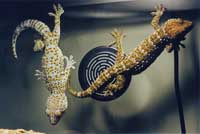Breeding Tokay Geckos
Sexing
Identifying the sex of Tokay geckos is fairly easy. Male tokays tend to be larger, thicker and have wider, more angular heads than females. Male Tokay geckos typically have brighter gray and blue base colors while females tend to be darker gray and brown base colors.
The most definitive way of sexing them is to check underneath between their rear legs and just above the vent for a line of pores. Adult male tokays have a very pronounced series of pores that form a somewhat V-shaped line or ridge that may have tiny, waxy protrusions. It should be very noticeable in mature males. Female tokay geckos also have these pores, but they are not as pronounced or obvious.
Never try to keep more than one male tokay per enclosure. Tokay geckos are very territorial and males will fight with each other resulting in injury or death. Several females may be kept together in larger tanks. Do not overcrowd. In the wild tokay geckos are very solitary and only seek each other out during mating season. For this reason, some people choose to keep their tokays separated except for a breeding season. If you notice any aggressive behavior between tank mates, separate them.
Mating
Tokay geckos should breed with little or no encouragement, if they are in good health. In the wild, tokay geckos breeding season begins in spring and last several months. This breeding season is marked by increasing daylight hours and rains. In captivity, this can be reproduced by increasing the humidity and lighting period by one or two hours. Feeding should be increased and a dish of calcium supplement kept available in the enclosure. This will ensure the female tokay gets sufficient calcium and food to lay healthy eggs.
Male tokays will often vocalize to attract a female with a loud booming bark. Other courtship behavior involves a lot of posturing and head bobbing. The male tokay gecko will then climb on top of the female, often grasping her by the neck, and attempt to mate with her.
Egg Laying
Female tokay geckos lay clutch of 2 eggs at a time. The eggs are initially soft and the mother forms them into their final shape with her rear feet as they harden. The eggs are adhered to a surface and cannot be removed without damaging them. Female tokays will often continue to lay their eggs in the same spot over and over. A single female may lay up to 3 or 4 clutches of eggs per year.
The eggs are glued to a surface and form a pure white, round domed shape measuring approximately 3/4" in diameter. Sometimes the mother will later eat the eggs. This may be because of a calcium shortage or perhaps the eggs were infertile.
Incubating Eggs
Eggs should be incubated on a vermiculite or other slightly moistened substrate. Maintain temperatures between 80 an 86 degree. Eggs should hatch in 90-120 days typically. Lower temperature can result in longer incubation time, up to 200 days. Incubation temperatures are also known to affect the sex of the hatchings. Higher incubation temperatures cause higher percentages of male hatchlings.
Raising Young
Tokay geckos are 2-3" long when they emerge from their egg. The first thing they do is molt and eat the old skin. They should be maintained in same, but seperate, conditions as adults. Feed them the small size crickets until they are large enough for adult sized crickets. A general rule of thumb is not feeding anything equal to, or larger, than the geckos head.
